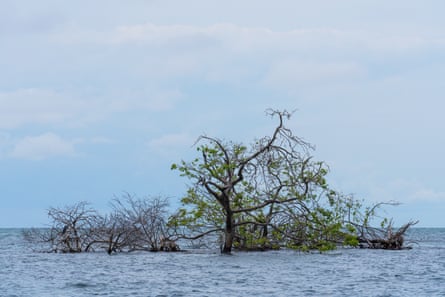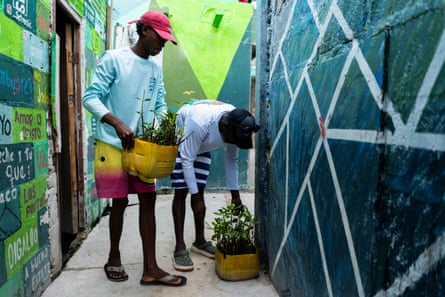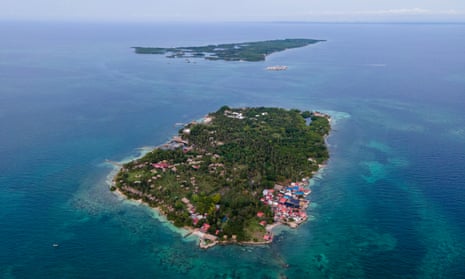People on the tiny Colombian island of Santa Cruz del Islote are used to having their sleep disrupted by the gentle lap of waves. But what might sound relaxing and blissful can actually be unnatural and menacing.
Rising from bed, islanders feel a splash as their feet touch the floor, and know that their homes have once again been flooded.
Santa Cruz del Islote, part of the San Bernardo archipelago, a few miles off Colombia’s Caribbean coast, is typical of many of the world’s low-lying coastal regions now at the forefront of the escalating battle against the climate crisis.
“It’s very worrying. The tides and sea levels are rising and flooding many homes. We’re worried that our islands are disappearing,” says Adrián Caraballo, a young islander and local climate campaigner.
Caraballo recalls wading through ankle-deep water on the streets during one recent flood on Santa Cruz del Islote, which is one of the most densely populated islands in the world.

The archipelago’s 10 tiny islands are part of a protected natural park and are home to about 1,500 people. They lie amid an intricate web of coral reefs and a dense maze of mangroves at an average of only 2 metres (6ft) above the waterline.
Global sea levels are expected to rise by up to 30cm by 2050, threatening the livelihood of San Bernardo’s people, and ultimately the very existence of the islands.
People here depend on small-scale artisanal fishing and tourism to survive. Some of the archipelago’s islands have already disappeared, succumbing to the rising waters, and those that remain are affected by erosion and changes in sea temperatures, acidity, and marine biodiversity due to the climate crisis. All this depletes the fish population that many depend on to ply their trade and feed their families.
“It’s deplorable because, besides the human factor, an important ecological heritage is being lost,” says Juan Manuel Díaz, the director of Fundación MarViva Colombia, a regional conservation group. “[San Bernardo] is now a completely different world to what I knew 40 years ago.”

The fate of Maravilla Island serves as a stark reminder of the archipelago’s predicament. Once known among locals as “Bird Island”, because of its flocks of migrating frigates, albatrosses and pelicans, the one-hectare (2.47 acre) islet was granted state protection for “its conditions to be preserved in perpetuity”. Yet it had vanished by 2017, swallowed by rising seas. Now it is nothing more than a snorkelling spot for tourists.
There had been earlier warnings: the islands of Carivanita and Pérdida reportedly also disappeared about 60 years ago, according to a 2019 study.
And Maravilla will not be the last in San Bernardo to vanish, according to local conservationists and scientists. “The long-term future for these islands is disappearance. It’s a shame,” says Díaz.

Both Ceycén and Panda Islands teeter on the brink, with locals fearing they may be submerged within 10 years. Years ago, Panda Island was split in two as the rising seas penetrated and eroded its web of mangroves.
Múcura Island is the largest in San Bernardo and is also battling the climate crisis. Flooding is commonplace, and one of the buildings most at risk is the primary school, which has about 30 pupils.
after newsletter promotion
For years, anxious islanders have feared for the safety of the school. Its foundations have already collapsed once, and many fear it could happen again.
Coastal erosion has also become a critical issue in San Bernardo. Múcura has the most extensive tourist infrastructure, with several hotels dotted along a coastline which has long been receding. Strong winds, rising tides and the indiscriminate felling of mangroves – vital to coastal protection – have accelerated the process.
A 2014 local government report estimated that erosion has affected 45% of San Bernardo’s coastlines. By 2040, 22% of Múcura will be flooded, according to the report. There has been no update in the nine years since the study.
“The climate crisis has a very important impact on the economic issues of the small islands, as food fishing and the coral reefs will be deeply affected,” says Sandra Vilardy, a prominent ecologist and, until recently, the Colombian vice-minister for the environment. “It impacts not only food security but also the physical security of the inhabitants.”
The islands are disappearing in plain sight, and locals, as well as scientists and environmentalists, accuse the government of ignoring the problem. They fear it is now too late to salvage the situation.

San Bernardo is caught in an administrative gridlock. It is under the jurisdiction of the state’s natural parks authority but is governed by the city of Cartagena, 48 miles away.
“Nobody is taking action. I don’t see any authority taking this issue seriously,” says Díaz. “It’s not in the park authority’s interests for those people to be there [in San Bernardo] because it goes against their conservation objectives for the park. But it’s also not their duty to invest in social matters either.”
Vilardy says administrative inefficiency is trapping the islands, though she claims it is “difficult” to make such cases a priority at state level. “The ministry of environment has no jurisdiction except to design policies.
“In insular territories such as San Bernardo, the relevant authorities get a little more entangled because the actual jurisdiction lies on the mainland, so islands and archipelagos have a lot of difficulty being incorporated into public administration,” she says.
Attempts by local people to stave off the threat of climate crisis have run against the park authorities’ environmental regulations, as they are said to interfere with the park’s protected landscape. Yet many islanders say they have no choice, and build rudimentary shell walls to guard against the waves. Some have resorted to concrete walls.

Caraballo, the environmental campaigner, is among those who have resorted to reforesting many of the degraded mangroves in hopes of helping the islands battle the rising tides and receding coastlines.
“We have to mitigate the impact through the planting of mangroves. If we had some [state] support, we’d see an improvement in the islands or some kind of recovery, but we just don’t have that support,” he says.
As the climate crisis rages on and the international community struggles to abide by its environmental commitments, Caraballo remains hopeful for a positive solution. Others have a bleaker outlook. “In the long term, there is nothing that can be done but run away,” says Díaz.
“What needs to be done is an evacuation plan. We still have time to do it progressively before tragedy strikes.”
